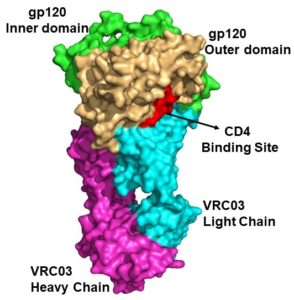To understand Envelope proteins and bNABs interactions: path towards HIV vaccine development.
HIV vaccine formulation is unarguably one of the trickiest medical feat to be tackled. Despite a decade of rigorous investigation on this aspect, the progress made has been miserable to develop an effective and potent HIV vaccine. VRC-class antibodies are one of the most broadly and potently neutralizing HIV-1 antibodies by identifying the viral envelope glycoprotein gp120. The surface gp120 comprises of inner and outer domains, and each domain adds two β strands to produce a bridging sheet. These domains and bridging sheet encompass the binding site of CD4 co-receptor, the binding of which stimulates the virus to infect host cells and then specifically bind a co-receptor. Hence, gp120 is extremely vital in facilitating HIV-1 attachment, and is a favorable target for researchers intended at mounting HIV-neutralizing drugs/vaccines.

Development of phytocompounds based effective inhibitor/drug molecules against viral infested HIV proteins.
Drug resistance has been a serious concern in treating HIV (Human Immunodeficiency Virus) infected patients with most of the presently sold drugs. HIV-1 protease (HIV-PR), one of the most crucial enzymes of HIV has been battered with numerous such types of drugs. Regrettably, these actions have simply led to mutations aided drug resistance in HIV-PR. However, the molecular origin of drug resistance in HIV-PR is not visibly understood. In the area of antiviral drug discovery, numerous reports on the antiviral activity of various medicinal plants against HIV targets have been reported.From last decades, scientists have turned towards nature, exploring to ascertain compounds that can be utilized as HIV antivirals. The demand for phytocompounds is mounting as they are usually measured to be safer, non-toxic, and economic compared to synthetic drugs. Nature exemplifies a massive resource of phytocompounds which can be explored with the goal of determining new leads that can be openly utilized as pharmaceuticals that can be augmented towards the advancement of novel and potent antiviral agents against HIV.

Development of phytocompounds based effective inhibitor/drug molecules against vector- borne diseases like Dengue/Chikungunya fever.
Dengue virus (DENV) and Chikungunya (CHIKV) transmitted by Aedessp. mosquito causes immense morbidity and mortality in subtropical and tropical regions of the world, which has been of foremost anxiety to governments and the World Health Organization (WHO). With no antiviral agents in specific or clinically approved vaccines to control this pathogen at the current time, mitigation is a challenging issue. Numerous tactics have been used in the exploration for dengue/chikungunya antivirals like screening of compounds against DENV/CHIKV enzymes and structure-based/computer-aided drug design. Phytocompounds, the chemical compounds produced by plants, have been used widely to treat a variety of diseases such as malaria. The demand for phytocompounds is mounting as they are usually measured to be safer, non-toxic, and economic compared to synthetic drugs. Nature exemplifies a massive resource of phytocompounds which can be explored with the goal of determining new leads that can be openly utilized as pharmaceuticals that can be augmented towards the advancement of novel and potent antiviral agents against CHIKV/DENV.
